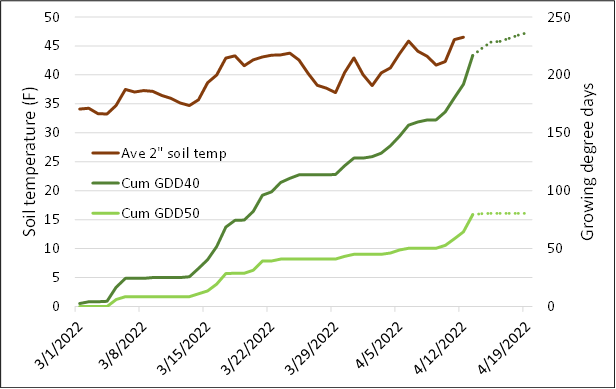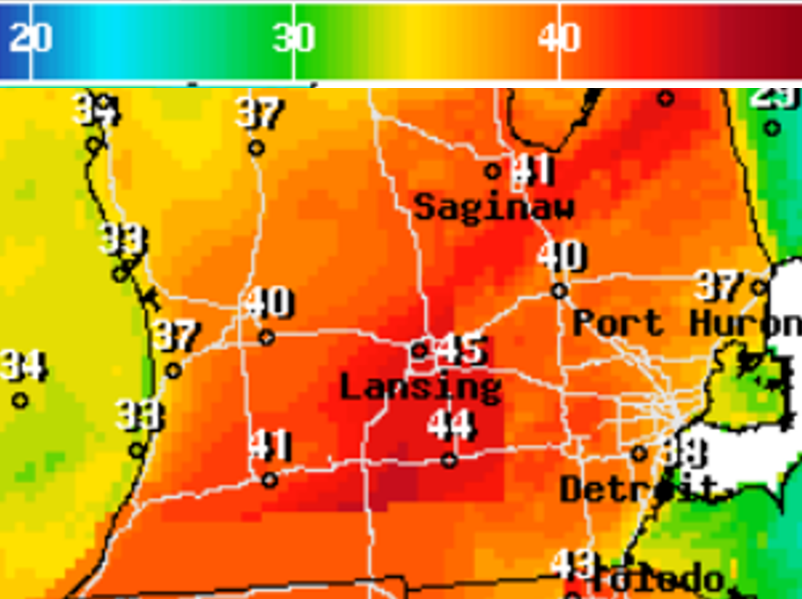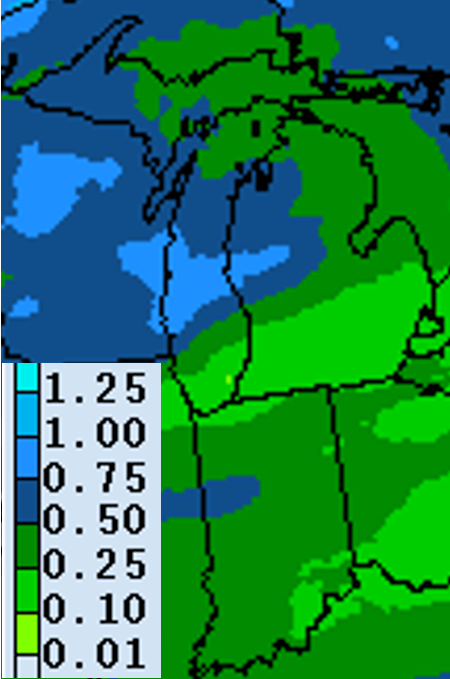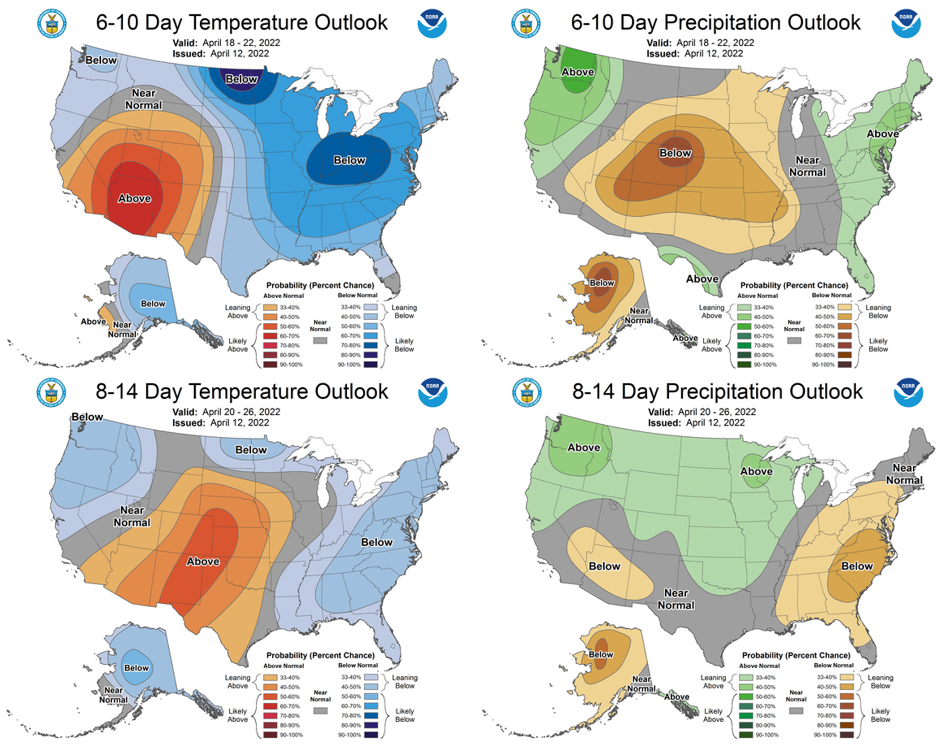Southwest Michigan field crops update – April 14, 2022
Some farmers were able to begin field operations this past week in between showers. The coming week should afford more opportunities to get fields prepped and planting underway.

Weather
Temperatures this past week were 1-2 degrees Fahrenheit warmer than normal for the eastern half of the state but were normal in the south-central and southwest. The weather system that is currently causing unusual blizzard conditions over North Dakota and Minnesota will be bringing cooler temperatures to Michigan over the next couple of days and into next week. Soil temperatures continue to hover near 45 F but are slowly increasing and will hopefully reach 50 F by later next week with a few warmer and sunny days in the forecast. Strong westerly winds are expected Thursday afternoon and through tonight continuing into Friday with gusts up to 55 mph this evening. The outlooks for most of the remainder of April call for below-normal temperatures to persist.


Precipitation this past week ranged from 50% below normal to 100% above normal depending on location, although rainfall totals fell short of predictions over the past 48 hours in the region. This continues to be a wet spring overall with most areas having received 1-4 inches more rain than normal over the past 30 days. The forecast for the coming week may give many their first opportunity to get fieldwork done as less than 0.25 inches of rain is expected, which is predicted to fall Monday through Thursday next week. The outlooks for the remainder of the month call for normal precipitation levels.



Crops and pests
Wheat in Michigan is rated at 39% good to excellent (34% fair) according to the current USDA Crop Report—a significant drop compared to a 70%-plus rating last year. The main causes are late planting last fall combined with freezing/flooding challenges this winter and spring. Most fields are still at Feekes 2-3 with tillering and stems beginning to become erect but no nodes visible. If a nitrogen (N) application has not yet been made, growers may end up putting all of their spring N on just before jointing (Feekes 5) depending on ability to get into fields soon. Jointing is the point at which the crown is above the soil surface and the first node is visible.
The recommendation for wheat N fertility follows the formula:
lbs actual N per acre = (1.33 x yield potential in bushels) – 13
This comes from Extension Bulletin E2904, Nutrient Recommendations for Field Crops in Michigan and is also used in the Tri-State Fertilizer Recommendations.
For more information about early-spring wheat management, check out the following Michigan State University Extension articles: “Evaluating wheat stands and spring management” by Dennis Pennington, MSU Extension wheat specialist; “Topdress nitrogen on wheat” and “Winter wheat response to nitrogen” by Darryl Warncke, MSU soil fertility professor emeritus; and “Topdressing wheat with nitrogen” by Martin Nagelkirk, MSU Extension wheat educator emeritus.
Potatoes are typically the first row crop that gets planted each spring, but with the weather conditions this year, there has not been much planting accomplished yet. It is true that 2021 was an unusually early planting year due to dry conditions, so having 75% of fields planted by now (like last year) would not be the norm. However, according to one of the larger potato companies in the region, only 10% has been planted thus far, so it looks like everyone will have a compressed planting season.
Trapping for true armyworm and black cutworm moths has begun in the region. As of April 8, few moths had been captured from either species in northern Indiana according to Purdue University’s Pest and Crop Newsletter. The traps in St. Joseph and Kalamazoo counties also yielded very few moths this past week. Peak flights typically don’t occur until early May, but with the weather system coming through this week from the southwest, we may see an uptick next week.

|
Trap counts for armyworm (A1-4) and black cutworm (B1-3) for April 12, 2022 | |
|---|---|
|
A1 |
3 |
|
A2 |
0 |
|
A3 |
1 |
|
A4 |
0 |
|
B1 |
0 |
|
B2 |
0 |
|
B3 |
0 |
Forage fertility
Forage fertility was the topic of this week’s MSU Extension Field Crops Virtual Breakfast with forage and cover crop specialist Kim Cassida. Of course, a good fertility program for any crop starts with consistent soil sampling. Sampling every three years at the same time of year is critical as soil test values change over the course of a year and using the same testing lab will help avoid inter-lab variability.
There is some disagreement among scientists as to the depth of sampling on a perennial hay or pasture field as there is going to be stratification with highest test levels at the surface. However, though the consensus says to sample at a 3 – 5-inch depth, Cassida suggests following the specific lab’s guidelines as their recommendations for fertilizer inputs will be based in part on a given depth of sampling. She also recommended farmers consider using grid sampling as many row crop farmers do and then making variable rate applications across fields to avoid over-fertilizing some areas and saving on the fertilizer bill. Obtaining a yield map using a forage yield monitor can also aid in creating a fertility prescription.
|
Average pounds of soil nutrient removed per dry ton of forage yield1 and per acre at 6 tons of dry hay yield per acre2. For legume or legume-grass mix hay, it is assumed that no N fertilizer is needed if the percent of legume is at least 30% of the stand. Table courtesy of Kim Cassida. | ||||
|---|---|---|---|---|
|
Nutrient |
Legume1 |
Grass1 |
Legume2 |
Grass2 |
|
Nitrogen |
70 |
50 |
421 |
298 |
|
Phosphate (P2O5) |
15 |
15 |
91 |
92 |
|
Potash (K2O) |
68 |
61 |
407 |
364 |
|
Calcium |
28 |
12 |
170 |
73 |
|
Magnesium |
6 |
5 |
3 |
27 |
|
Sulfur |
5 |
4 |
30 |
27 |
Based on Dairy One Feed Library, 4/13/22
Specific nutrient recommendations begin with getting the pH correct depending on the type of forage being grown. For example, the optimum pH for alfalfa is 6.5-6.8 while for grasses and other legumes it is 6.0–6.5. Plan to apply lime if needed at least six months before applying fertilizer if possible to allow time for the lime to take effect—this will maximize the crop’s ability to uptake the nutrients applied and minimize the risk of loss due to volatilization, runoff, etc. Consider applying sulfur (S) at 4–5 pounds per dry ton of forage removed as N deficiency symptoms can sometimes be due to a lack of S. As there is no good soil test for sulfur, conduct tissue sampling to measure this and other micronutrient levels.
Lastly, Cassida discussed the pros and cons of utilizing manure for hay fields and pastures. Though legumes do not need the N in manure, they will utilize it so there is reduced risk of losing the N. Manure also provides many micronutrients and a boost to the microbial community, thus increasing the value compared with mineral fertilizers. However, the timing and manner of application are important to avoid traffic damage to new shoots, leaf burning and fouling of foliage, and applying “chunky” manure that will end up in bales in the next cutting. Manure can also reduce palatability of the forage and increase the spread of weed seeds.



 Print
Print Email
Email